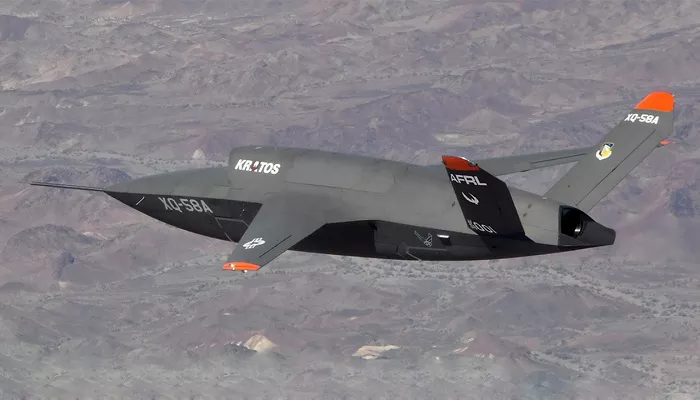The XQ-58 Valkyrie is an advanced unmanned aerial vehicle (UAV) developed by Kratos Defense & Security Solutions in collaboration with the U.S. Air Force Research Laboratory. Designed as a low-cost, stealthy, and versatile platform, the Valkyrie serves multiple roles in modern military operations. This article provides a comprehensive overview of the XQ-58 Valkyrie, its purpose, design, capabilities, and its significance in contemporary warfare.
Design and Development
The XQ-58 Valkyrie was conceived under the U.S. Air Force’s Low Cost Attritable Aircraft Technology (LCAAT) project. The goal was to create an affordable UAV that could perform various missions while being expendable if necessary. The Valkyrie features a sleek, stealthy design with a trapezoidal fuselage, V-shaped tail, and an air intake above the fuselage, minimizing its radar cross-section and enhancing survivability in contested environments.
Key Specifications
- Length: 9.14 meters
- Wingspan: 8.2 meters
- Maximum Takeoff Weight: 2,722 kg
- Payload Capacity: 544 kg
- Engine: Turbofan engine with approximately 2,000 lb of thrust
- Cruise Speed: Mach 0.72
- Operational Ceiling: Up to 45,000 feet
- Range: Approximately 5,556 km (3,000 nautical miles)
Operational Capabilities
The XQ-58 Valkyrie is designed to perform a variety of missions, including:
- Intelligence, Surveillance, and Reconnaissance (ISR): Gathering real-time data to support decision-making on the battlefield.
- Electronic Warfare (EW): Disrupting enemy communications and radar systems.
- Suppression of Enemy Air Defenses (SEAD): Targeting and neutralizing enemy air defense systems.
- Strike Missions: Delivering precision-guided munitions against designated targets.
The Valkyrie’s modular design allows for rapid reconfiguration to suit specific mission requirements, enhancing its versatility and utility in various combat scenarios.
Loyal Wingman Concept
One of the primary roles envisioned for the XQ-58 Valkyrie is that of a “loyal wingman.” In this capacity, the UAV operates alongside manned fighter aircraft, such as the F-35 Lightning II, providing support in the form of additional firepower, surveillance, and electronic warfare capabilities. This manned-unmanned teaming approach enhances the effectiveness and survivability of both platforms.
Autonomy and Artificial Intelligence
The Valkyrie incorporates advanced autonomy and artificial intelligence (AI) systems, enabling it to operate with minimal human intervention. These capabilities allow the UAV to perform complex tasks, such as threat identification, navigation, and targeting, independently or in coordination with other assets. The integration of AI also facilitates real-time decision-making and adaptive mission planning.
Launch and Recovery
The XQ-58 Valkyrie is designed for runway-independent operations. It utilizes a rocket-assisted launch system and a parachute recovery mechanism, allowing it to be deployed from austere environments without the need for traditional airfield infrastructure. This capability enhances the UAV’s operational flexibility and reduces logistical constraints.
Communication and Networking
Equipped with advanced communication systems, the Valkyrie can seamlessly integrate into existing military networks. It supports data links such as Link 16 and the Multi-Function Advanced Data Link (MADL), enabling secure and reliable communication with other platforms. This connectivity facilitates coordinated operations and enhances situational awareness across the battlespace.
Cost-Effectiveness
A key advantage of the XQ-58 Valkyrie is its cost-effectiveness. With an estimated unit cost significantly lower than that of manned fighter aircraft, the Valkyrie offers a budget-friendly solution for expanding aerial capabilities. Its affordability allows for the deployment of larger UAV fleets, increasing operational reach and resilience.
Testing and Deployment
The Valkyrie has undergone extensive testing to validate its performance and capabilities. Notable milestones include successful flight tests demonstrating autonomous operations, integration with manned aircraft, and the execution of various mission profiles. These tests have confirmed the UAV’s readiness for operational deployment and its potential to enhance military effectiveness.
Global Military Integration
The XQ-58 Valkyrie is being considered for integration into various military forces worldwide. Its versatility, affordability, and advanced capabilities make it an attractive option for enhancing aerial operations. For more information on global military developments, visit World Military and explore their Military articles.
Conclusion
The XQ-58 Valkyrie represents a significant advancement in unmanned aerial technology. Its combination of stealth, versatility, autonomy, and cost-effectiveness positions it as a valuable asset in modern military operations. As defense strategies continue to evolve, the Valkyrie is poised to play a crucial role in shaping the future of aerial warfare.


